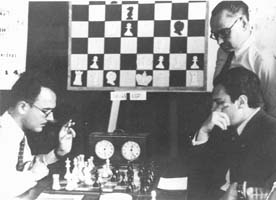
Edward Winter
In November 2005 Miquel Artigas (Sabadell, Spain) kindly presented in Chess Notes (C.N.s 4008 and 4015) six photographs discovered in the archives of the Club d’escacs Sabadell. All were taken in August 1945, during a small tournament in Sabadell won by Alexander Alekhine and, unexpectedly, two of the pictures have given rise to curious mysteries.

Vallés v Lupi
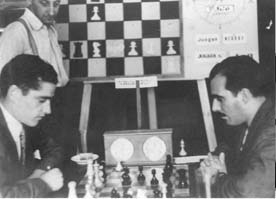
Terrazas v Ros
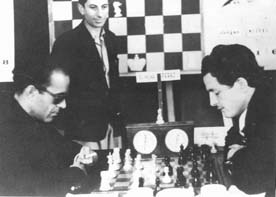
Mena v Pérez
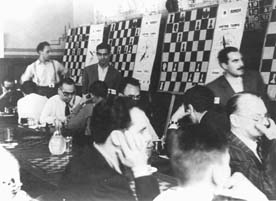
General view of the playing area, with Alekhine on the far right.
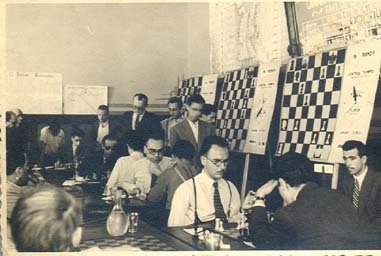
Round nine
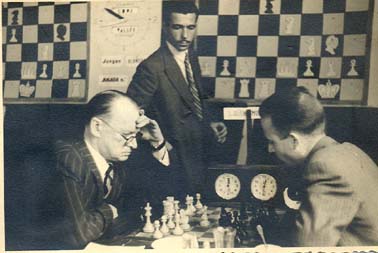
Alexander Alekhine (left)
Miquel Artigas commented in C.N. 4008:
‘The international chess tournament held in Sabadell (Spain) on 2-10 August 1945 is one of the lesser-known events in which Alekhine played. As far as I am aware, the main sources of information are the books on Alekhine by P. Morán (Spanish and English editions) and by L.M. Skinner/R.G.P. Verhoeven. Surprisingly, in the 367-page book Federació Catalana d’Escacs 75 anys d’historia (Barcelona, 2001) I have found (on page 63) only eight lines on the tournament, and not even the crosstable, which is given in the other books mentioned above. Nor could I find anything about the tournament in Ajedrez Español, which was the only chess magazine published in Spain at that time.’
The six photographs from Sabadell, 1945 were provided by Mr Artigas with the permission of the President of the Club d’escacs Sabadell, Oscar Oliva.
Mystery one: alleged Alekhine v Muñoz miniature
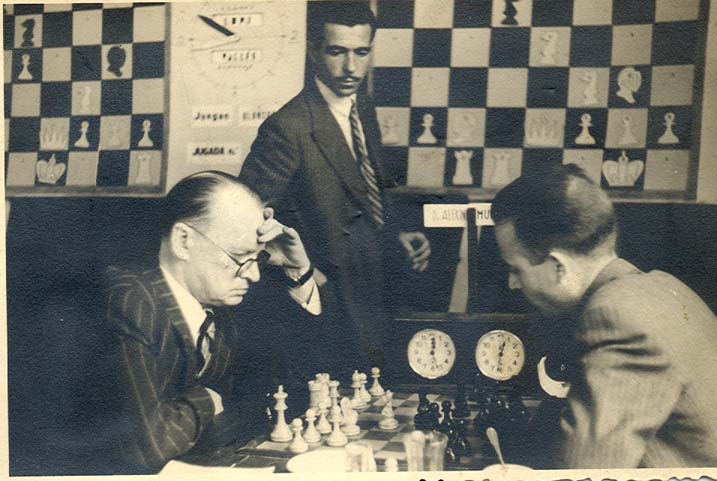
In C.N. 4016 we commented that from the identification of the players at the bottom of the demonstration board it seemed clear that Alekhine was facing Muñoz, yet the position bears no relation to that game as presented on pages 231-233 of A. Alekhine Agony of a Chess Genius by P. Morán (Jefferson, 1989). Nor were we able to match the position with any other game. The game-score given by Morán as Alekhine v Muñoz is as follows:
1 d4 d5 2 c4 e6 3 Nf3 Nf6 4 Bg5 Bb4+ 5 Nc3 dxc4 6 e4 c5 7 Bxc4 cxd4 8 Nxd4 Qa5 9 Bxf6 Bxc3+ 10 bxc3 Qxc3+ 11 Kf1 Qxc4+ 12 Kg1 O-O 13 Qg4 g6 14 e5 Nc6
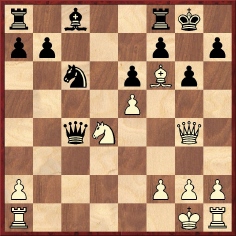
15 Nf5 Resigns.
The question, therefore, is whether Morán’s book, which gave no source for the score of the Alekhine v Muñoz game, was mistaken. The same 15-move game was also given as Alekhine v Muñoz on page 728 of Alexander Alekhine’s Chess Games, 1902-1946 by L.M. Skinner and R.G.P. Verhoeven (Jefferson, 1998), but the source specified there was merely Morán’s book. On the other hand, if Morán was correct that the 15-move game occurred between Alekhine and Muñoz, how could the above photograph be explained?
In C.N. 4357 Leonard Barden (London) wrote:
‘The real encounter between Alekhine and Muñoz, which must be the pictured game, looks like a French Defence with 3 Nd2/Nc3 dxe4 4 Nxe4. In his game against Julio López in a tournament at Almería later the same month Alekhine chose a rather similar formation to that shown in the photograph, and especially Bf4 with Bg3 after Black’s Nd5. The black formation in the picture is indistinct, but Muñoz has gone for ...a6 and perhaps ...Bd7 rather than the ...b6/Bb7/Re8 set-up which encouraged Alekhine’s sacrificial king’s-side attack in the López game.
Page 728 of the Skinner/Verhoeven book on Alekhine records that his game against Muñoz was played in the ninth and final round, on 10 August. Tournament photographers often turn up on the first day or the final day, so that is consistent too.
But in that case, who was the loser of the 15-mover? 14 e5 is essentially just a one-move cheapo based on Black missing the obvious Nf5 threat. If Black answers 14...h5 to give the king a flight square at h7, then 14 e5 is not very good. The database shows 14 Qf4 as the normal continuation, with Trifunović v Gligorić, Mar del Plata, 1953 as a principal example. So 14 e5 looks like the kind of move that is played in a simultaneous exhibition or, if in a tournament, against a truly weak player.
Since Mena finished eighth out of ten in Sabadell and had a name which could easily have become warped into Muñoz he might seem the most likely player to have lost the 15-move game. However, page 727 of Skinner and Verhoeven’s book records that of the four missing games Alekhine was White in all of them except the Mena one. The missing games were listed as follows:
Round two, 3 August: Mena v Alekhine
Round three, 4 August: Alekhine v Vilardebó
Round five, 6 August: Alekhine v Ros
Round seven, 8 August: Alekhine v Pérez.Assuming that the above details are correct, the question, therefore, is whether the loser of the 15-move game was Vilardebó, Ros or Pérez.’
To try to take the matter forward we asked in C.N. 4387 whether the miniature had been published, by Morán or anyone else, before 1972. C.N. 4394 mentioned that Alekhine’s tournament schedule was given, together with the available game-scores, on pages 727-728 of the Skinner/Verhoeven book:
Round one (2 August): Alekhine v Vallés. ½-½.
Round two (3 August): Mena v Alekhine. 0-1. Game unavailable.
Round three (4 August): Alekhine v Vilardebó. ½-½. Game unavailable.
Round four (5 August): Terrazas v Alekhine. 0-1.
Round five (6 August): Alekhine v Ros. 1-0. Game unavailable.
Round six (7 August): Medina v Alekhine. ½-½.
Round seven (8 August): Alekhine v Pérez. 1-0. Game unavailable.
Round eight (9 August): Lupi v Alekhine 0-1.
Round nine (10 August): Alekhine v Muñoz 1-0.
See, furthermore, pages 225-235 of A. Alekhine Agony of a Chess Genius and pages 291-304 of the original Spanish edition of Morán’s book, Agonía de un Genio (Madrid, 1972).
Also in C.N. 4394 Leonard Barden presented a further detailed analysis of the affair:
‘Alekhine had five games as White and four as Black. This means that in a normal tournament draw (round one: 1 v 10, 2 v 9, etc. and round nine 9 v 1, 8 v 2, etc.) he would be in the top half of the pairing table. He never had two successive games as White, which signifies that he was number five in the pairings. That is demonstrated by the crosstable on page 225 of his book ¡Legado! (Madrid, 1946):
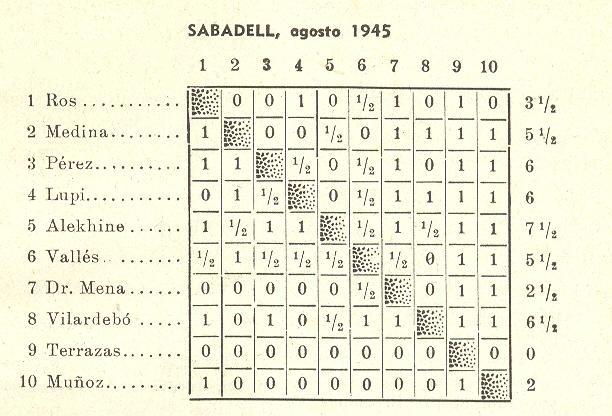
The round-by-round pairings given in Skinner and Verhoeven’s book are consistent with the order of the draw shown in the crosstable, i.e. 1 Ros, 2 Medina, 3 Pérez, 4 Lupi, 5 Alekhine, 6 Vallés, 7 Mena, 8 Vilardebó, 9 Terrazas and 10 Muñoz. Assuming normal pairings, this means that the final round was Terrazas v Ros, Alekhine v Muñoz, Vilardebó v Medina, Mena v Pérez and Vallés v Lupi, and that is what is pictorially shown, except that Vilardebó and Medina are only in the group picture – which also has “9 ronda” on the demonstration boards.
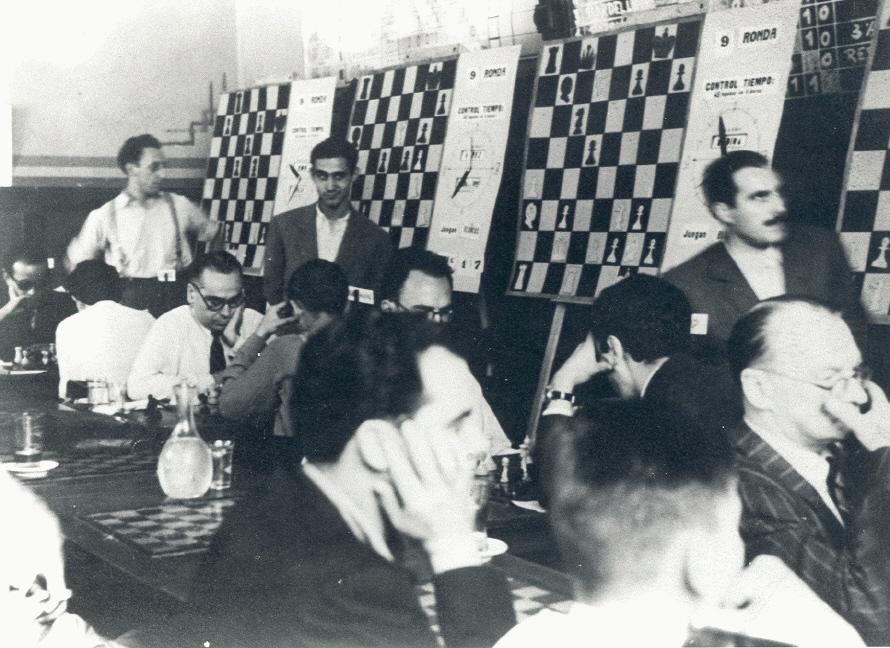
The larger group shot (below) also shows a couple of tournament charts above the demonstration boards. The right-hand one seems to be some local subsidiary event, but the left-hand one is complete, with 11 cards, the top one a heading and No. 10 partly obscured by the demonstration board. The names are illegible, but it can be judged whether it is a long or short word, and this too is consistent.
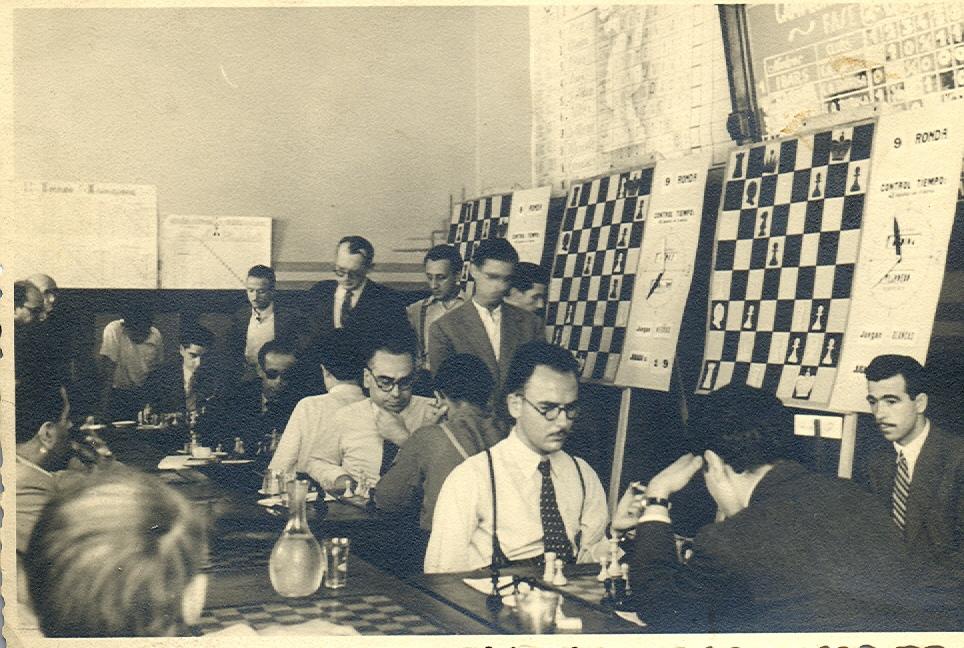
It is therefore absolutely sure that the Alekhine v Muñoz photograph of the French Defence game is from round nine, after about one hour’s play, as shown by the clocks, and that the 15-move game cannot have been played between those two players in the Sabadell tournament. In any case, apart from his score of only 2/9 in that event Muñoz seems unknown to chess history, and too weak to have played such a sharp variation.
Alekhine drew with Vilardebó so, on the face of it, the 15-mover would have to be either Alekhine v Pérez or Alekhine v Ros, which are the two missing games which he won as White.
The only other known game by Alekhine in his entire career which opens 1 d4 d5 2 c4 e6 3 Nf3 Nf6 4 Bg5 Bb4+ (most other opponents played 4...Nbd7) appears to be the consultation game Alekhine and Frank v Bogoljubow and Pfaffenroth, Warsaw, 1941. It varied from the 15-mover with 12...Bd7? 13 Rc1 Qa6 14 Nxe6 fxe6 15 Rc8+ Kf7 16 Rxh8 gxf6 17 Qh5+ Ke7 18 Qc5+ Kf7 19 Rf8+ Kg7 20 Qe7 Resigns. See pages 670-671 of Skinner and Verhoeven’s book. The game was also given by Morán in his notes to the 15-mover which he incorrectly headed Alekhine v Muñoz.
In his annotations to the consultation game on page 185 of the 1 December 1941 issue of Deutsche Schachblätter Alekhine commented that “after 12...O-O White would obtain a winning position by means of 13 Qg4 g6 14 e5! (threatening Nf5)”. In other words, the 15-mover had essentially appeared four years earlier.
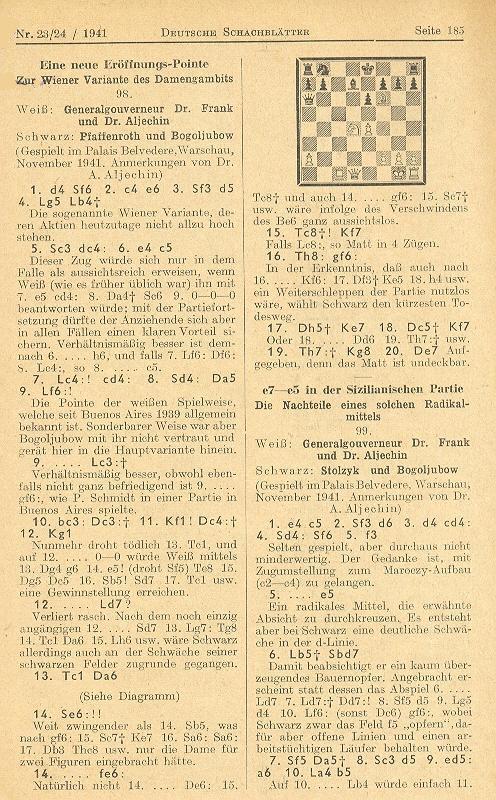
Ajedrez Español (page 37 of the February 1942 issue) also printed the consultation game, with notes by López Esnaola, although 12...O-O was not mentioned:
Ajedrez Español, February 1942 (submitted by Miquel Artigas)
During his last five years Alekhine normally played 1 e4, mainly reserving 1 d4 for selected stronger opponents. Then after 1...Nf6 2 c4 e6 3 Nf3 Nf6 or b6 he would go into a Catalan or Queen’s Indian. So would a lesser player like Pérez or Ros choose, as Black, an obscure system with such a dubious reputation four years later in Sabadell, and why should Alekhine choose 4 Bg5 rather than his usual 4 g3 against a random opponent when he was not to know that the game would go down the Vienna Variation route?
I met Francisco Pérez (who died in 1999) at the 1958 and 1960 Olympiads, at which time he was a strong and ambitious International Master. Later he emigrated from Spain to Cuba, where he could play on a high board, become the national trainer and compete in the Capablanca Memorial tournaments in Havana. He was theoretically up-to-date in the King’s Indian, which he used in 1958, and I find it hard to believe that he would have tried to surprise Alekhine with a rare dubious line and then fallen into a one-move trap.
In the meeting between Alekhine and Ros one would expect 1 e4 by Alekhine (against a weak opponent) or, if 1 d4, a Catalan. And if Ros really knew enough to choose the sharp Vienna Variation he might be expected to know the above-mentioned consultation game. In the 15-mover Black’s play is both too strong (knowledge of a sharp theoretical line) and too weak (the worst possible move was played at the first opportunity). 14...Nc6 (the only independent move in the 15-mover) is really bad, as it allows not only 15 Nf5 but also 15 Nxc6, after which 15...Qxg4 permits 16 Ne7 mate and if 15...Qxc6 then 16 Qf4, followed by Qh6-g7. It is also worth mentioning that the consultation game was given on pages 230-231 of Schachgenie Aljechin by H. Müller and A. Pawelczak (Berlin-Frohnau, 1953), with a note at move 12 which included the line 12...O-O 13 Qg4 g6 14 e5 Nd7 15 Qf4 Nxf6. However, 14...Nd7 is answered by 15 Nf5. The German book was obviously unaware of Alekhine’s annotations in Deutsche Schachblätter, which is surprising as Müller was a well-known theoretician. However, the book’s other suggested reply to 14 e5 is 14...Re8, which creates a hole for the black king at f8 and therefore stops the 15 Nf5 trick.
Of course, if Alekhine won the 15-mover against neither Pérez nor Ros that means that it was not played by him in the Sabadell tournament at all. There is also the dog that failed to bark in the night argument. It has not been shown that “Alekhine v Muñoz” appeared in print before the original Spanish edition of Morán’s book in 1972, yet other Alekhine miniatures from the war years were published in contemporary sources. Alekhine, in 1945, badly needed to improve his public image following the anti-Semitic articles controversy. How better to do so than by a 15-move queen sacrifice game (never mind that it was analysis) which every space-limited chess journalist the world over would pounce on? But Alekhine himself, his publicist Lupi, who was present, Medina, who was a chess journalist and was also present, and the Sabadell organizers all kept silent. In particular, the game did not appear in Alekhine’s book ¡Legado!, which, indeed, had no games from the event. So was the game ever played, or did somebody merely create it from Alekhine’s annotations to the consultation game in Deutsche Schachblätter?’
Nobody has yet been able to identify Alekhine’s opponent in the 15-move game.
Mystery two: which Terrazas?
The other photograph submitted by Miquel Artigas which has given rise to a mystery is the following:
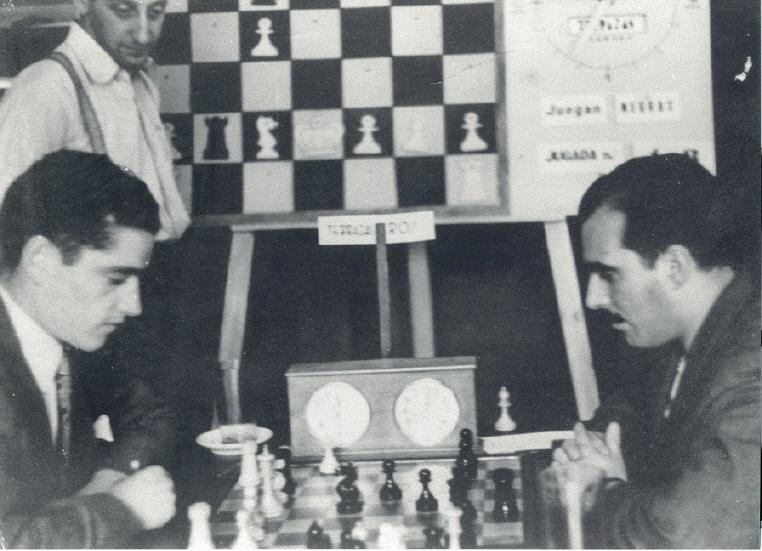
Terrazas v Ros
In C.N. 4008 we expressed puzzlement at the picture of Terrazas, because on page 227 of the English edition of Pablo Morán’s book on Alekhine the translator, Frank X. Mur, added the following note at the end of the Terrazas v Alekhine game:
‘Alekhine’s victim was 11 years old. Years later he wrote: “I only recall that the imposing figure of an Alekhine made one play with a deep reverential awe, especially at that age.” – Filiberto Terrazas to Frank X. Mur, letter dated 19 January 1979.’
C.N. 4015 mentioned that the original Spanish edition of Morán’s book (Madrid, 1972) gave no forename, or even initial, for Terrazas and asked whether he was really Filiberto. (A player of that name certainly existed.) Mr Artigas wrote in that same C.N. item:
‘In Sabadell there was a player named Teodoro Terrazas Elizando. In the 1944-45 season he was registered with the Federación Catalana de Ajedrez as a first-category player for the Sabadell club, and I have been lucky enough to find his identity card for that season. I am almost sure that he was the participant in Sabadell, 1945, but further checking is required.’
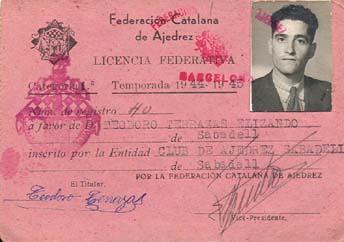
Subsequently (C.N. 4392) Mr Artigas reported:
‘I have been doing some research in the Arxiu històric de Sabadell, where the local newspaper Sabadell of the time is available. Unfortunately there are only two pieces of information about the tournament preliminaries and no further news about the event, crosstable or scores.
However, the newspaper presented Terrazas as a local player, and in my opinion it is now clear that it was Teodoro Terrazas Elizando, and not Filiberto Terrazas as stated by Frank X. Mur.’
As regards Filiberto Terrazas, C.N. 1180 gave a game lost by him against Fidel Castro in Havana, 1966, from page 323 of the November 1966 Jaque Mate: 1 e4 e5 2 f4 exf4 3 Nf3 Bd6 4 d4 h6 5 e5 Bb4+ 6 c3 Ba5 7 Bxf4 g5 8 Bg3 Qe7 9 Be2 d6 10 exd6 cxd6 11 Qa4+ Nc6 12 d5 Bd8 13 dxc6 b5 14 Qxb5 a6 15 Qa4 g4 16 c7+ Bd7 17 c8(Q) Rxc8 18 Qd4 gxf3 19 Qxh8 Qxe2 mate. In C.N. 4049 we reproduced this photograph, taken during play, from the back-cover of Terrazas’ book La guerra apache en México, which was first published in 1972:
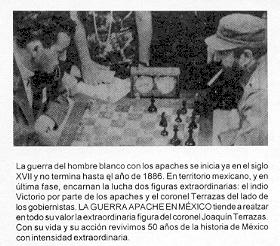
As mentioned on pages 8-9, in 1962 Terrazas wrote El águila caída, a biographical novel concerning Carlos Torre.
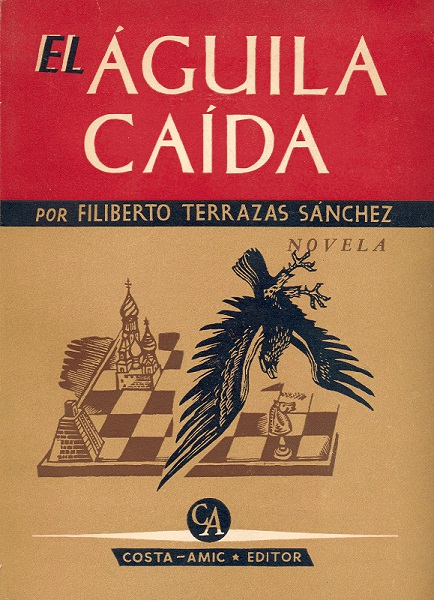
Acknowledgement: Miquel Artigas
Another work by Filiberto Terrazas Sánchez:
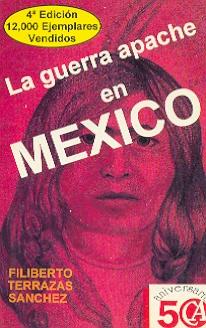
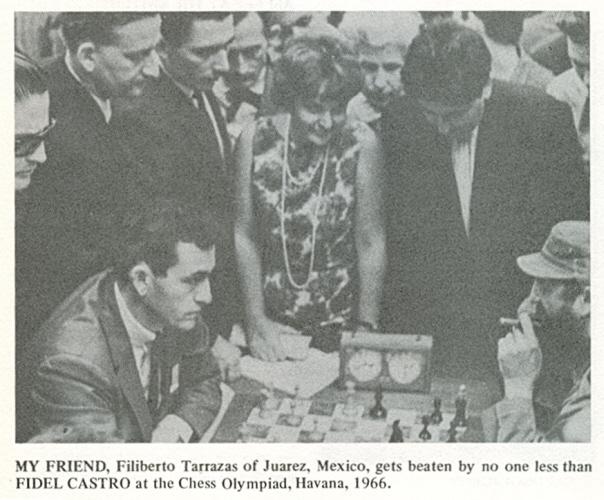
Above is a photograph of Filiberto Terrazas from page 143 of With the Chess Masters by G. Koltanowski (San Francisco, 1972). In C.N. 6034 we mentioned that the apparent resemblance between Filiberto and Teodoro Terrazas left us more puzzled than ever.
Does Filiberto Terrazas have anything to do with Sabadell, 1945? Not according to any of the local evidence, but there is his claim in the Morán book. In C.N. 4665 Frank X. Mur (Oakland, CA, USA) informed us:
‘After Koltanowski published the Terrazas v Alekhine game, stating that the former was aged 11 in 1945, I asked him to give me the address of Terrazas, who was an expatriate in Mexico. Koltanowski did so, and Terrazas’s reply to me of 19 January 1979 included the following two sentences, the second of which was translated into English on page 227 of A. Alekhine Agony of a Chess Genius:
“Como con toda razón expresa Usted, a los 11 años de edad yo no estaba como para guardar copias de las partidas de torneo. Sólo recuerdo que la imponente figura de un Alekhine le hacía a uno jugar con un profundo temor reverencial particularmente a esa edad.”’
And there the matter currently stands. At Sabadell, 1945 did Alekhine face the adult local player Teodoro Terrazas Elizando or the 11-year-old Filiberto Terrazas?
Andrés Vicente Sanz (Valencia, Spain) sends us two newspaper cuttings which provide some additional information and complications.
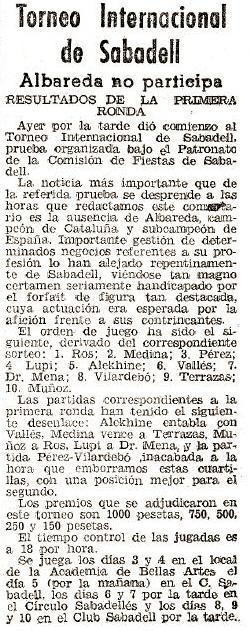
The above report on page 2 of El Mundo Deportivo, 3 August 1945 gives the results of the first round, played the previous day, and lists, in the final paragraph, the remaining tournament schedule: daily rounds at various venues in Sabadell from 3 to 10 August, with play in the morning on 5 August.
However, El Mundo Deportivo of 4 August 1945 (page 3) has the following:

This presents not only the results of round two in Sabadell but also a report on a simultaneous exhibition by Alekhine (+17 –4 =9) in Saragossa, the same day (3 August). The display took place from 18.00 to 22.30, and our correspondent wonders how Alekhine could have played a tournament game in Sabadell in the afternoon and, starting in the early evening, an exhibition about 250 kilometres away (accompanied in Saragossa by F. Lupi).
(6456)
This is all that A. Soltis could be bothered to give on page 271 of 365 Chess Master Lessons (London, 2017):
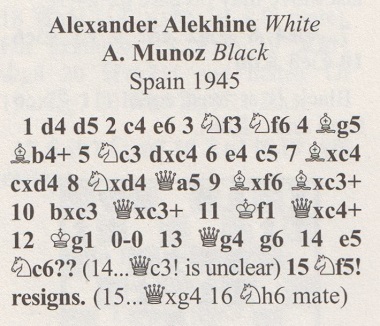
See too C.N. 11332, as well as the contribution from Christian Sánchez (Rosario, Argentina) in C.N. 11786.
As reported in an endnote on page 263 of Chess Explorations, C.N. 1854 offered an excerpt from the reminiscences of Francisco José Pérez in the March 1989 Revista Internacional de Ajedrez (page 14). Regarding Alekhine he said:
‘While playing in a tournament in Sabadell in 1945, Alekhine said that he did not have the courage to commit suicide; his wife had written to him saying that she did not want to hear from him any more.’
For the full text of C.N. 1854, see Alekhine’s Death.
To the Chess Notes main page.
To the Archives for other feature articles.
Copyright: Edward Winter. All rights reserved.